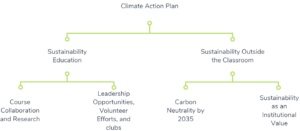< Previous Section (The Problem Overview)
Next Section (About the FYS) >
Sustainability at Lafayette College:
While AASHE is a public interest group, there are many different influences that help shape Lafayette College’s path towards a more sustainable future. Political, moral, ethical, and market failures are all incentives to implement public policy. Ethically, many U.S. citizens recognize the need for more environmentally sustainable solutions. Economically, solar panels are becoming increasingly more affordable. Political pressures, both from informal policy actors and interest groups, and technological advancements help to shape the current policies. Similar to policy makers in the United States, Lafayette College experiences pressures to implement policy and change on an institutional level. In response to the political pressures of being a state-of-the-art college concerned with sustainability, Lafayette crafted the Climate Action Plan, which articulates the future goals and initiatives related to sustainability at Lafayette. The Kirby Solar Array is the next step in Lafayette College’s quest to achieve their overarching goals outlined in the Climate Action Plan.
Lafayette College’s Climate Action Plan:
Lafayette’s Climate Action Plan starts with a clear vision: to achieve carbon neutrality by or before 2035. Going a step further, the plan reiterates its fundamental belief in the importance of mitigating climate change, the role the college has in preparing students to be active leaders in this movement, and the hope to use campus as a living laboratory. The plan states, “By providing students with rigorous academic preparation and research training within an interdisciplinary, collaborative environment, our faculty are already preparing the next generation of scientists, engineers, architects, and policymakers to make meaningful contributions to society. Making carbon neutrality and sustainability more broadly strategic focal points of that preparation is only appropriate, as climate change is an urgent, complex, and persistent challenge. Through leadership opportunities, volunteer efforts, course collaborations, and a host of environmental research efforts led by faculty members, students will leave Lafayette understanding their ability to help shape an environmentally sustainable future.”
On top of the educational components Lafayette students will receive in the quest for carbon neutrality, Lafayette also believes this movement will have a positive impact on student recruitment, the Easton community, and will work to unify the campus. The plan states, “…reaching carbon neutrality should increase organizational efficiency, reduce risk, and help to attract, retain, and motivate students and employees… Additionally, strong sustainability practices help to recruit highly skilled and motivated faculty and staff who are eager to work for organizations making a positive impact on the world. Research, education, and outreach for reducing greenhouse gas (GHG) emissions helps to strengthen community relations, enhance partnerships, and unify the campus around a shared sense of purpose.” The support and push for sustainability efforts on Lafayette’s campus have certainly become an important vision of the school’s larger goals and educational tools for its students. In just a few years since the first Climate Action Plan at Lafayette was drafted, Lafayette has reduced carbon emissions, declared sustainability as one of Lafayette’s three core institutional values, signed the “We’re Still in Pledge” in support of climate action to meet the goals of the Paris Climate Agreement, and created degree programs in Environmental Studies and Environmental Science. (Lafayette College Office of Sustainability, 2021)
The Kirby Solar Array:
The motives behind the installation of The Kirby Solar Array echo the values and missions outlined in the Climate Action Plan. The Kirby Solar Array project was headed by Delicia Nahman, the director of the Office of Sustainability at Lafayette. On the motives behind the array’s construction she says, “This project is intended to visually articulate to the Lafayette community and visitors the College’s commitment to achieve carbon neutrality and use the campus as a living laboratory.” Lafayette recognizes the influence they have as a higher education institution to both contribute to solving global climate change as well as educating its students on the importance of sustainability.
Proposed Solution:
For the Kirby Solar Array to truly manifest its intended potential, an educational component is indispensable. The Kirby solar array can act as not only a physical representation of the college’s commitments towards sustainability, but also as a hands-on educational tool for students and even the Easton community. Without the space on campus to construct an on-site solar array with capabilities to power most of Lafayette’s campus, the Kirby array will be most influential through its integration into the curriculum. The curricular integration portion of the Climate Action Plan states that “embracing the opportunities presented by transforming our campus into a living laboratory will enhance the learning environment and deepen the educational experience Lafayette provides.” Team Solar FYS proposes a first-year seminar as an optimal avenue for the Kirby Solar array to develop into a facility that reaches sustainability initiatives and values both inside and outside of the classroom. Through the addition of this proposed course, use of the Kirby Solar Array can extend beyond clean energy production and its being as a physical representation of Lafayette’s sustainability goals. (Lafayette College Climate Action Plan, 2020)
The figure below dissects Lafayette College’s Climate Action Plan to show how its missions are multifaceted and interconnected. The right side of the diagram shows the CAP components that reach beyond Lafayette curriculum while the left side of the diagram shows how the CAP influences the college inside the classroom and on an individual experiential basis.

Figure 5: “Breakdown of the CAP Components” (As created by Team FYS Solar, 2021)